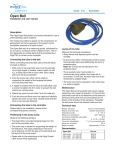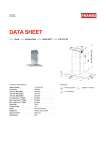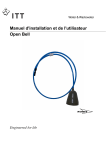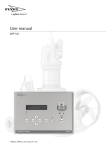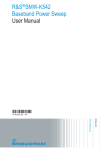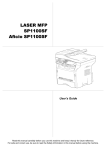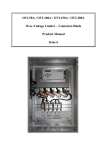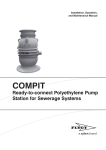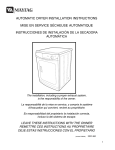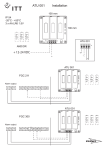Download FGC 211 User Manual
Transcript
Issued: 4/12 FGC 211 Installation and user manual This manual is applicable to the following versions: Hardware: FGC 211 Display board: AFH1901 Rev 1.01 Main board: AHH1901 Rev 1.01 System Software: 2.42 or later 1 Supersedes: Issued: 4/12 Supersedes: Contents 1.Read This First ...................................... 4 4.7. Reset Function ....................................... 18 4.8. Display Language .................................. 18 1.1. Introduction .............................................. 4 1.2. Safety Regulations for Owner/Operator... 4 1.3. Guarantee ................................................. 4 1.4. Used Symbols .......................................... 4 1.5. Safety Instruction ..................................... 4 5. Configuration....................................... 19 5.1. Introduction ............................................ 19 5.2. Startup .................................................... 20 5.3. Configuring Level Switches ................... 20 5.3.1. Using a Stop Level Switch ...................... 20 5.3.2. Stopping a Pump After a Time ............... 20 5.4. Configuring a Level Sensor ................... 20 5.4.1. Start, Stop and High Levels .................... 21 5.5. Pump Configuration ............................... 21 5.5.1. Maximum Motor Current .........................21 5.6. Restoring Default Values ....................... 21 2.Short Guides .......................................... 5 2.1. Installation Checklist ............................... 5 2.2. Getting Started ......................................... 6 2.3. Menu Reference Chart ............................. 8 3.Installation ............................................. 9 3.1. Introduction ............................................ 9 3.2. Installing the FGC .................................. 9 3.2.1. Explosive or Flammable Environment ..... 9 3.2.2. Equipment Cubicle ................................... 9 3.3. Installing Sensor or Switches ................ 10 3.3.1. Cabling ...................................................... 10 3.3.2. Pneumatic Sensor LTU 301 ...................... 10 3.3.3. 4–20 mA Level Sensor .............................. 10 3.3.4. ENM-10 Level Regulators ......................... 11 3.3.5. Pressure Switch ........................................ 11 3.3.6. Flush timer or similar start blocking relay .......................................................... 12 3.4. Connecting Thermal Contact ................ 12 3.5. Connecting Alarm Output ...................... 12 3.6. Internal Buzzer ....................................... 12 3.7. Installing Power Supply ......................... 13 3.7.1. Cabling ..................................................... 13 3.7.2. Power Supply ........................................... 13 3.7.3. Earthing (Grounding) ............................... 13 3.7.4. Overvoltage Protection ............................. 13 3.7.6. FGC 24 VDC Supply 13 3.8. FGC 211 in a LPSS application ............ 13 3.8.1. Background .............................................. 13 3.8.2. Preventing over pressure in system ......... 14 3.8.3. Avoiding simultaneous pump starts ......... 14 3.8.4. Handling pressure increases during operation ................................................... 14 3.8.5. Preventing over flow at high pressure ...... 14 3.8.6. Resetting over current protection ............. 14 3.8.7. Flushing sewage from the system............ 14 3.8.8. System overview ....................................... 14 3.9. Wiring Diagram ..................................... 15 3.10. Controller Specification ........................ 16 6. Additional Configuration .................... 22 6.1. Introduction ............................................ 22 6.2. Level Configuration ................................ 22 6.2.1. Backup Pump Control ............................ 22 6.2.2. Stop Delay .............................................. 22 6.3. Pump Control ......................................... 22 6.3.1. Fixed Pump Delays ................................ 22 6.3.2. Automatic Maintenance Run .................. 22 6.3.3. High Temperature ................................... 22 6.3.4. EX-classified Environment ...................... 22 6.3.5. Maximum Run Time for a Pump ............. 23 6.3.6. Pump Response ..................................... 23 6.4. Alarm Configuration ............................... 23 6.4.1. Alarm Delay ............................................ 23 6.4.2. Audible or Visual Alarm Indication ......... 23 7. Basic Operation................................... 24 7.1. Introduction ............................................ 24 7.2. Viewing Runtime Data ............................ 24 7.3. Resetting Runtime Data ......................... 24 7.4. Controlling the Pump ............................. 24 7.4.1. Automatic Control (Auto Mode) ............. 24 7.4.2. Manual Control (Manual Mode) ............. 24 7.4.3. Blocked Pump (Blocked Mode) ............. 24 7.4.4. View Control Status ............................. 24 7.5. Pump Failure Block ................................ 25 7.6. Handling Alarms ..................................... 25 7.6.1. Acknowledge an Alarm .......................... 25 7.6.2. Viewing Alarms ....................................... 25 7.6.3. Clear the Alarm Log ................................ 25 8. Troubleshooting ........................................ 26 8.1. Introduction ............................................ 26 8.2. Basic Problems ...................................... 26 8.2.1. Power Supply ......................................... 26 8.2.3. Pump Failure .......................................... 26 8.2.4. Blocked Pump ........................................ 27 8.3. Diagnostic Programs ................................. 27 4.Operator Panel ...................................... 17 4.1. Introduction ........................................... 17 4.2. Front Panel ............................................ 17 4.3. Display ................................................... 17 4.4. Push Buttons ......................................... 17 4.5. Menus .................................................... 17 4.5.1. Using the Menus ....................................... 18 4.6. Pump Control ........................................ 18 2 Issued: 4/12 Contents 9. Appendix A: FGC Descriptions.......... 28 9.1. LED Descriptions ................................... 28 9.2. Alarm Descriptions ................................ 29 9.3. Menu Descriptions ................................ 30 10. Appendix B: LPSS Scenarios .......... 33 10.1. Operation variants ............................... 10.2. Permanent blocking ............................ 10.3. Start, run and stop ............................... 10.3.1. Scenario A - Normal pressure ............. 10.3.2. Scenario B - High pressure at start ..... 10.3.3. Scenario C - High level ........................ 10.3.4. Scenario D1 - Over current at start ...... 10.3.5. Scenario D2 - Current rising ................ 33 33 33 33 33 33 33 33 3 Supersedes: Issued: 4/12 Supersedes: 1. Read This First! 1.1. Introduction 1.5. Safety Instruction Before starting to use the FGC 211, read this chapter carefully. It contains general information on documentation, safety and guarantee. Electrical wiring must be carried out only by a qualified electrician. All electrical installation work must be carried out with the equipment disconnected from the power supply, without any possibility of being made live, and in accordance with local regulations. 1.2. Safety Regulations for Owner/ Operator • All government regulations, local health and safety codes shall be complied with. Observe all precautions for handling electrostatic sensitive devices before opening the unit. • All danger due to electricity must be avoided. 1.3. Guarantee • Modifications or changes to the unit/installation should be carried out only after consulting Xylem Inc. The FGC has a high degree of protection against moist and dirt, but should always be installed so that it will not be unnecessarily exposed to water or the risk of external physical damage. • Original spare parts and accessories authorized by the manufacturer are essential for compliance with the terms of the guarantee. The use of other parts may invalidate any claims for warranty or compensation. A FGC may be used only in the manner specified by the manufacturer. 1.4. Used Symbols The manufacturer does not allow any internal modifications to be made in the unit. Safety instruction Always keep this manual with the installed unit. Personal safety Use cables that minimize interference from electrical and magnetic fields. Run the cables in a way that further minimize interference. Safety instruction Personal safety - dangerous voltage The many potential sources of such interference include relay coils, solenoid valves, switches, thyristor units, earth (ground) currents and static discharges. Special attention value Apparatus or component damage Susceptibility to interference also varies with the electrical environment i.e. to factors such as cable lengths, screening and the use, or otherwise, of interference suppression. Many problems can be prevented by good planning. Special information Special information about a function. Special information Special information about alarms. 4 Issued: 4/12 Supersedes: 2. Short Guides 2.1. Installation Checklist This is a short installation checklist. It is included for convenience only, and is in no way a replacement for the Installation manual. Check- mark Installation step Plan the installation of the FGC to: • Avoid all danger due to electricity • Comply with the safety regulations • Comply with the guarantee regulations • Observe precautions for electrostatic sensitive devices • Avoid unnecessary exposure of the FGC • Minimize interference from electrical/magnetic fields Make sure the main power supply for the FGC is off. Mount the FGC. Ensure that the temperature in any equipment cubicle will be neither too high, nor too low. Install desired level sensor or switches in the pump sump, and connect them to the FGC. If used, connect the thermal contact for the pump to the FGC. If not used, make sure to place a jumper lead on the thermal contact input in the FGC. If used, connect an external alarm device to the common alarm output. Make sure a separate fuse is used for the main power supply. Connect an earthing (grounding) conductor to the FGC. (Recommended) Provide the main power supply with overvoltage protection. Connect the FGC both to the main power supply and to the pump. Check that all connections are correctly installed. Turn on the main power supply. Configure the FGC. 5 More information Chapter “Read This First” on page 4, especially Chapter “Safety Instruction” on page 4. Chapter “Installing the FGC” on page 9. Chapter “Installing Sensor or Switches” on page 10. Chapter “Connecting Thermal Contact” on page 12. Chapter “Connecting Alarm Output” on page 12. Chapter “Power Supply” on page 13. Chapter “Earthing (Grounding)” on page 13. Chapter “Overvoltage Protection” on page 13. Chapter “Installing Power Supply” on page 13. Chapter “Getting Started” on page 6. Issued: 4/12 Supersedes: 2.2. Getting Started Set Default Values - Browsing to the Menu This is a short description on how to get started with the FGC 211. The description is included for convenience only, and is in no way a replacement for the Installation manual. At delivery, the FGC is set to factory defaults. (They are listed in “Menu Descriptions” on page 31–33). 30-32) To use a different set of default values: The figure below shows the front panel of FGC 211. 1. Press the button repeatedly until the display shows the following: Power Display Alarm status Relay status High level Pump status LED LED LED LED LED General... 7_ 2. The underscore after the menu indicator (7_) indicates that there are submenus. Press the 1 Esc Reset OK Push buttons to navigate menus Reset push button Push button to change between automatic and manual pump control Push button to block pump operation button to access them. 3. Press the button repeatedly until the display shows the following: Set default val. 7_8 No 0 FGC 211 OK The following information is shown in the menu: • Menu name: "Set default val." • Menu indicator: "7_8". This indicator is shown for 3 seconds only. • Parameter value: "No". Selecting Language Set Default Values - Changing Values When the FGC is started for the first time, the display will show the following: One of the following sensor configurations is installed in the pump sump: Language < N ot s e le c t e d > • An analogue level sensor (4-20 mA). The sensor measures the level in the pump sump. When the sump level exceeds a specified start level, the pump starts. It runs until the sump level drops below a specified stop level. • Start and stop level switches. When the level in the pump sump exceeds the start level switch, the pump starts. It runs until the sump level drops below the stop level switch. • Only start level switch. When the level in the pump sump exceeds the start level switch, the pump starts. It runs a specified time, and then stops. To proceed: 1. Press the button repeatedly until the display shows the desired language, for example "English". 2. Press the OK button to save selected language. The display will show "Value stored", and then change its text to the specified language. For each configuration, there is a set of default values. If the following is installed.. 4-20 mA level sensor Start and Stop level switches Only Start level switch FGC is used in PSS LPSS 6 application Use the following default values... Compit analogue Level regulator Level reg. time PC Pump Issued: 4/12 To select defaults: 5. Press the the right. OK 1. Press the button to be able to change the value in the displayed Set default val. menu. 6. Press the button repeatedly to specify the last digit. For example, if the maximal current for the pump is 6.0 A, enter the digit "0". For example, if the installation includes both start and stop level switches, select "Level regulator". Set default val. Level regulator 3. Press the button to move the cursor a step to H i g h c u r re n t P 1 6.3 A 2. Press the button repeatedly to until the name of the defaults is displayed. OK Supersedes: 7. Press the OK button to save the changes. The display will show "Value stored", and then the new parameter value. button to save the changes. H i g h c u r re n t P 1 6.0 A The FGC is restarted and initialised with the selected set of default values. Specify Maximal Motor Current 8. Press the Esc button to exit the submenu. The display will again show the P1 current menu. (The shown current can differ from 0.0 A). If the motor current for the pump exceeds this limit, the pump is stopped and blocked. An alarm is also generated. P1 current 3_ 00 .0 A To specify the maximal current: Checking the Installation button repeatedly until the display 1. Press the shows the P1 current menu. (The shown current can differ from 0.0 A). When the above configuration is complete, the unit is in automatic mode, and should be ready for operation. The LEDs on the front panel indicate unit status, including potential problems. If there is a problem, check that everything is installed and configured correctly. P1 current 3_ 00.0 A For information on how to interpret the LEDs and troubleshoot, refer to: 2. Press the OK button to access the submenu. The display will show the High current P1 menu: High current P1 3_1 5.3 A 3. Press the OK button to be able to change the value in the displayed menu. • “LED Descriptions” on page 29 28 • “Alarm Descriptions” on page 30 29 • “Troubleshooting” on page 27 26 What’s Next When ready: A flashing cursor will appear. High current P1 5.3 A • FGC is now initialized with default values for the specific installation • Pump is now ready to run. Trimming the FGC 4. Press the button repeatedly to specify the first digit. For example, if the maximal current for the pump is 6.0 A, enter the digit "6". If necessary, use the FGC menus to trim the installation, see also: 7 • “Menu Reference Chart” on page 9 8 • “Configuration” on page 19 20 • “Additional Configuration” on page 23 22 Issued: 4/12 Supersedes: 2.3. Menu Reference Chart This chart shows the menu structure in the FGC. Alarm log 1 Level 2_ A Start level 1 2_1 A Stop level 1 2_2 P1 current 3_ High current P1 3_1 Operating data 4_ P1 start counter 4_1 P1 run hour 4_2 Pump control 5_ P1 state 5_1 Stop delay range 5_2 Hold out run time 5_6 Blocking enable 5_7 Alarm setup 6_ Al.delay Powfail 6_1 Resp. err. alarm 6_2 General 7_ Control mode 7_1 Stop condition 7_2 Automatic reset 7_6 H. lim retry del. 7_7 A High level 2_3 A A Stop delay time 5_3 B Run time 7_3 L. lim retry del. 7_8 B Sensor range 2_4 A Sensor calib. 2_5 Hi.lev. run time 5_4 Max run time 5_5 Common alarm 7_4 EX mode 7_5 System version 7_9 Set default val. 7_10 Diagnos. Program 7_11 8 Language A Only shown when the Control mode menu (7_1) is set to “Analogue”. (4-20 mA level sensor) B Only shown when the Control mode menu (7_1) is set to “Digital”. (Level switches) 8 A Issued: 4/12 3. Installation 3.1. Introduction The installation descriptions and figures can refer to terminals on the main board. For information on locations, see also “Wiring Diagram” on page 15 16. The following symbols can also be used in the figures: Normally open Normally closed 3.2. Installing the FGC 3.2.1. Explosive or Flammable Environment The FGC must not be installed in an explosive or flammable environment. 3.2.2. Equipment Cubicle The FGC can be installed in an equipment cubicle. Ensure that its operating temperature is between -4°F to +113°F: • Heating will normally be required in winter if the cubicle is located outdoors or in a similarly cold environment. • Heating of the cubicle is also recommended to avoid condensation. • The cubicle temperature may become too high in summer if ventilation is inadequate. 9 Supersedes: Issued: 4/12 3.3. Installing Sensor or Switches Supersedes: 2. Check that the open bell is free from solid matter. 3. Make sure that no solid matter collects at the bottom of the sump below the open bell. Use either a level sensor, a start level switch, or both start and stop level switches. As backup, a high level switch can be used together with the start and stop level switches, as well as with a level sensor. 4. Mount LTU 301 in the FGC. 5. Connect the pneumatic tube from the open bell system to LTU 301. FGC 211 in LPSS application 6. Connect LTU 301 as follows, see also figure below: The components recommended for employing FGC 211 in a LPSS application are highlighted in the following texts by this light-bulb symbol. – Connect the black wire to terminal 18 (-). – Connect the white wire to terminal 19. 3.3.1. Cabling – Connect the red wire to terminal 20 (+). Cables carrying different types of signals must be run separately. For example, make sure cables to an analogue level sensor are run separately from cables to digital level switches. 4-20mA 12 3.3.2. Pneumatic Sensor LTU 301 13 14 15 16 17 18 19 20 Black wire The pneumatic sensor LTU 301 is used together with an open bell system. The system includes a cast bell and a pneumatic tube. White wire Red wire Suitable for LPSS application In the standard LPSS application, the digital terminals 15 and 16 normally reserved for Start level and Stop level regulators are occupied by a pressure switch and a stop relay. Instead an analog sensor is used. LTU 301 is ideally suited for this application. 3.3.3. 4–20 mA Level Sensor To install a 4–20 mA level sensor: 1. Install the level sensor in the pump sump. There are two versions of LTU 301. One is for ATEXinstallations. For more information, refer to the Installation and operation manual for the sensor. If the ATEX version is used, the open bell and only the open bell can be installed in an explosive or flammable environment 2. Connect the sensor shield to the earth (ground) terminal of the FGC, that is, connect the shield cable to one of terminals 5–8. To install LTU 301: 1. Install the open bell system in the pump sump, see also example in figure below. For more information, refer to the Installation and operation manual for the open bell system. 200 mm 500 mm Open bell 10 Issued: 4/12 – If used, connect the Stop level switch to terminals 14 and 15. 3. The analogue input in the FGC (terminals 18–20) has its own power supply, and can carry a maximum total load of 12 V. 4-20mA Connect the sensor as follows, see also figure below: – Connect the black wire to terminal 19. 8 9 10 11 12 13 14 15 16 17 18 10 11 12 13 14 15 16 17 18 19 20 Black wire – If used, connect the Start level switch to terminals 14 and 16. 4-20mA 7 9 Blue wire – Connect the red wire to terminal 20 (+). 6 Supersedes: 19 20 4-20mA 9 Black wire Shield wire 10 11 12 13 14 15 16 17 18 19 20 Blue wire Red wire Black wire – If used, connect the High level float to terminals 14 and 17. 3.3.4. ENM-10 Level Regulators (Level Switches) Suitable for LPSS application To install one or more ENM-10 level regulators: In the standard LPSS application, the High level switch is used. 1. Install the level regulators in the pump sump. For more information, refer to the Installation and operation manual for the regulators. 4-20mA 9 High level float 10 11 12 13 14 15 16 17 18 19 20 Blue wire Black wire Start level switch 3.3.5. Pressure Switch Suitable for LPSS application Stop level switch In the standard LPSS application, a pressure switch can be used. An optional pressure switch can be connected to the pumping outlet, preventing the FGC from starting the pump while the pressure in the sewage system is high. 2. Connect the ENM-10 level regulators to FGC as follows: – If used, connect to terminals 14 and 16. (Switch open = high pressure, closed = low). For normal operation, use the blue and the black wires. (The switches will be normally open ). Terminal 14 is the common power supply terminal for all level switches. 4-20mA 9 11 10 11 12 13 14 15 16 17 18 19 20 – For more information, refer to the installation instruction of the pressure switch. Issued: 4/12 Supersedes: 3.5. Connecting Alarm Output 3.3.6. Flush timer or similar start blocking relay The common alarm output is a potential free, alternating relay with a maximum rating of 250 VAC (5 A). The output can be used to activate an audible or visual alarm device, for example a lamp or a siren. Suitable for LPSS application In the standard LPSS application, a flush timer (essentially a type of stop relay) can be used. The common alarm output does not supply power for the external device. It must be must be supplied from another source. A flush timer allows the sewage level to rise in the well above the normal start level. The increased sewage volume is then used for purging the sewage system. Connect the external device to terminals 9 and 10. – If used, connect to terminals 14 and 15. (Switch open = blocking, closed = not blocking). 4-20mA 6 4-20mA 7 8 9 10 11 12 13 14 15 16 17 18 19 20 Wire with supply ~/+ 9 10 11 12 13 14 15 16 17 18 19 20 When the common alarm output is: – For more information, refer to the installation instruction of the flush timer. 3.4. Connecting Thermal Contact • passive, the relay closes between terminals 9 and 11. • activated, or the power supply is off, the relay closes between terminals 9 and 10. Passive output When a pump is installed in an explosive environment, the thermal contact for the pump must be connected to the FGC. 9 10 11 Active output 9 10 11 If the thermal contact for the pump is: • ~/+ used, connect the wires from the thermal contact to terminal 12 and 13 in the FGC. 3.6. Internal Buzzer 4-20mA 9 • 10 11 12 13 14 15 16 17 18 19 ~/+ When an alarm is generated, the internal buzzer sounds automatically. To deactivate the buzzer functionality, remove the jumper to the buzzer, see also below. 20 not used, make sure a jumper lead is placed between terminal 12 and 13 in the FGC. 4-20mA 9 10 11 12 13 14 15 16 17 18 19 J16 Jumper pins for buzzer 20 The thermal contact in the pump is normally closed . Power Fail On 12 Issued: 4/12 3.7. Installing Power Supply Supersedes: 3.7.6. FGC 24 VDC Power Supply 3-phase 400 VAC (With Neutral Input) Below describes how to connect the power supply to Make sure to comply with the “Safety Instruction” on page 5. 4. the FGC. Below it is described how to connect the power supply to the FGC. 3.7.1. Cabling Make sure to run power and signal cables separately. 3.7.2. Power Supply A separate fuse must protect the FGC power supply. Flygt recommends the use of automatic switch acting on all poles. Power Supply 24 VDC If a Flygt pump is connected in accordance with the instructions for its electrical connection, its direction of rotation will always be correct. 3.8. FGC 211 in a LPSS application When connecting a pump of a different brand, the direction of rotation must always be checked, even if the Phase fault LED does not light up. 3.8.1. Background In response to demands for a simple, efficient and reliable solution for a LPSS system, Xylem Inc. proposes an application where FGC 211 is used in combination with a Flygt PC-pump (i.e. a Progressive Cavity -pump). 3.7.3. Earthing (Grounding) An equipment earthing (grounding) conductor must be connected to one of the earth terminals in the FGC (terminal 5–8). The application presented here is typically intended for situations where a number of family houses (e.g. villas), each with its individual sewage tank, are connected to a common pressurised sewage system. The FGC controls the pump that empties the sewage tank into the system. The earthing conductor should be connected to the best possible earth, such as an earthed mounting plate or an earth rod. Remember that the earthing conductor must be as short as possible. The shields of all shielded cables must be earthed by connecting them to one of the earth terminals in the FGC. 3.7.4. Overvoltage Protection Flygt recommends that the mains power supply unit be provided with overvoltage protection (with lightning protection). Since this will make the FGC less sensitive to overvoltage, the FGC can be used in more severe environments. The protection should be connected in series with the power supply, preferably to a separate earth (ground), such as an earth rod, although connection to the earth busbar in the distribution box may sometimes suffice. A 6–10 mm² conductor should be used to connect the overvoltage protection to earth. 13 A few problems that need to be addressed are presented here, in order to demonstrate how certain functions and component accessories are employed in the application. Issued: 4/12 Supersedes: 3.8.2. Preventing over pressure in system 3.8.6. Resetting over current protection Problem: The individual pump controls must prevent dangerous pressure levels by regulating the number of pumps allowed to operate simultaneously. Problem: In the LPSS application,it is likely that over current protection will occasionally stop a pump. Previously FGC 211 could only handle a single restart attempt. If this failed, due to the over current state still remaining, restarting would be permanently blocked and a service technician would be required before the pump could be started again. Solution: High pressure in the system is detected by a pressure switch connected to the pumping outlet. When pressure is too high, the FGC is prevented from starting the pump. As a result, some units may have to wait for other units to finish pumping. High pressure is also detected indirectly by the FGC, while monitoring the pump current. Should the work load on the pump be too high, the current protection (i.e. motor protection) trips the pump. This not only protects the pump from damage but also protects the whole system from high pressure. Note: Using over current protection in this manner is viable for PC-pumps. For centrifugal pumps on the other hand, over current is more likely caused by solids or debris clogging the pump, necessitating a service stop. 3.8.3. Avoiding simultaneous pump starts Problem: The work load on the system is highly variable; Many households will be pumping sewage during approximately the same morning and evening hours. Should a power down occur, the situation will be further aggravated; When power is re-established, many pumps may attempt to start pumping simultaneously, causing sudden pressure increases in the system. Solution: This problem is already handled in the FGC by the power-on delay (see “Fixed Pump Delays” on 22) which randomizes the start of individual pumps page 23) within a 120 s time frame. 3.8.4. Handling pressure increases during operation Problem: When the pump starts, pressure in the outflow increases and may exceed the sensor’s limit. Solution: The pressure switch may only block the pump start, i.e. when the pump is already running, only over current protection can stop the pump prematurely. Solution: It is now possible to enter a value for the number of allowed restarts from 1 to 200. As soon as the FGC successfully restarts the pump, the internal counter of the number of consecutively blocked start attempts is nullified. 3.8.7. Flushing sewage from the system Problem: In normal operation, sewage in the tank seldom rises above the start level. This may cause residue to build up around the tank wall. Additionally, the limited volumes pumped out of the tank with each pumping cycle may not create sufficient flush to clear out the sand that may be settling in the pipes. Solution: A flush timer is used for blocking pump start for a given time period. (Xylem Inc. does not advocate any particular settings for time delay or interval, as these are determined by the actual situation.) In this way, the sewage is occasionally allowed to rise above the start level. The increased sewage volume aids in flushing the system. To prevent over flow, the high level switch over rides the flush timer and may initiate the flush when necessary. 3.8.8. System overview This is a schematic view of the standard (*) and optional (**) components of the LPSS application: PS** FGC211* T* H ** FT** 3.8.5. Preventing over flow at high pressure Problem: A high sewage level suggests that the tank may be in danger of over flowing. This must be avoided! Solution: When the high sewage level is reached, the pressure switch signal is no longer allowed to block the pump start and the FGC can start the pump normally. Note: Over current will still block the pump from running. In order for the pump control to operate appropriately, the blocking function is modified by the settings for number of restart attempts described under the next heading. 14 P* OB* Standard components are the Tank (T), Pump (P), FGC 211 and Open Bell level system (OB), with LTU 301 sensor. Optionally a High level float (H), Pressure Switch (PS) and Flush Timer (FT) may be fitted. Issued: 4/12 Supersedes: 3.9. Wiring Diagram Main board AHH 1901 is used to control 1 pump. The layout and contents are specified below. Location Description Terminal Power P1 P2 P3 P4 Power supply 1, 4 24 VDC Earth terminal: 4 pcs 6 mm2. 5–8 Fuse F2: T100mA L for internal use. Current transformer for the pump I/O I1 I2 Common alarm output, potential-free contact. Max. 250 VAC / 5 A. Thermal contact input for the pump. If not used, make sure a jumper lead is placed on the input 9 –11 12–13 I3 Stop level switch input Terminal 14 is a common terminal for all level switches (stop, start and high level) 14, 15 I4 Start level switch input Terminal 14 is a common terminal for all level switches (stop, start and high level) 14, 16 I5 High level switch input Terminal 14 is a common terminal for all level switches (stop, start and high level) 14, 17 I6 Analogue level sensor input, 4-20 mA 18–20 Connector C1 C2 Jumper pins for internal buzzer. (Main board version 1.00 has no internal buzzer, and no pins). Connection for display unit LED L2 Power on indicator L1 Power Fault Indicator 15 Issued: 4/12 Supersedes: 3.10. Controller Specification Denomination Relay Outputs Model Part. no FGC 211-2000001 40-501830 Common alarm Voltage free, Max load 230 VAC (5 A) Pumps LCD Display 1 Analogue input Yes Analogue level 4-20 mA3 3 The supply from the FGC can carry max 12 VDC. 1 Consists of: Qty. 1 – Circuit Board Qty. 1 – Display Card Qty. 1 – Ribbon Cable Qty. 1 – Overlay Terminals Signal 1.5 mm2 Power 6 mm2 Earth Terminal 6 mm Power Supply Rated voltage Current consumption, internal Rated pump current 1-phase Basic fuses Internal fuse Type of level sensors to be used 24 VDC (20-28 VDC) 100 mA at 24 VDC Pneumatic sensor LTU 301 (4-20 mA) with 0-2.5 m sensor range. Max. 9.9 A, Min. 0.5 A External level sensor (4-20 mA) ENM-10 external level regulator 100 mA (non-replaceable) Options and Accessories Approvals and Standards EMC emission standard EMC immunity standard LVD electrical safety CE Marking Level control accessories: EN61000-6-3 EN61000-6-2 EN/IEC 61010-1 • Level regulators ENM-10. Different level switches (start, stop and high level) that provide digital input signals. • Open bell system, and pneumatic sensor LTU 301. The open bell system includes a cast bell and a tube that can be connected to a pneumatic sensor. It transforms the generated pressure to an analogue signal (4-20 mA). Environment Operational temperature2 - 4° F to +113° F Storage Temperature - 4° F to +158° F Humidity (non-condensing) 90% RH Operator Panel Class 1, IP 54, CAT II Altitude Max. 6562 ft Pollution degree 2 2 • Pressure sensor. It transforms the measured pressure to an analogue signal (4-20 mA). • High water module. It is used to detect a high level in the pump sump. The LCD display will update slower below 32° F. Material Operator Panel ABS V0 Data Processing Power Processor PIC18F4620 Executed word length 8 bits Clock frequency 32 MHz Text memory 64 kB Watchdog Yes User Interface Display LCD 2x16 characters Push buttons 9 pcs Alarm indications 4 LEDs FGC status indications 3 LEDs Digital Inputs Start switch Stop switch High level switch Thermal contact 16 Issued: 4/12 Supersedes: 4. Operator Panel 4.1. Introduction 4.4. Push Buttons FGC 211 is a pump controller designed for single pump installations and household usage. Available push buttons are listed below. Esc 4.2. Front Panel Escape The figure below shows the front panel of FGC 211. Power Display Alarm status Relay status High level Pump status LED LED LED LED LED Left arrow Right arrow Up arrow 1 Esc Reset OK Down arrow 0 OK FGC 211 Push buttons to navigate menus Reset push button Push button to change between automatic and manual pump control Reset Push button to block pump operation The panel contains: • Display to show the different menus. • Push buttons to navigate menus and change values. • A set of LED indications, see also “LED Descriptions” on page 29. 28. • Any open menu is closed. 0 Manual pump stop and block 1 Automatic mode and manual pump start You use the menus to configure the FGC, and view relevant information, such as runtime data and alarms. The display shows the current menu. When the display has been idle for 10 minutes: Light is switched off. Reset 4.5. Menus 4.3. Display • OK The following information is generally shown in a menu: • Menu name, for example Pump Control. • Menu indicator, for example "5_" or "5_1". It is shown for 3 seconds only. If the indicator ends with an underscore, there are submenus. • Parameter value. For a complete list of menus, see also “Menu Descriptions” on page 31. 30. 17 Issued: 4/12 4.6. Pump Control 4.5.1. Using the Menus 1. Display the desired menu: Use the 1 and 0 buttons to change between automatic and manual pump control, see also “Controlling the Pump” on page 25. 24. – Press the button to browse forwards one menu at a time. – Press the button to browse backwards one menu at a time. – Press the OK button to show the first menu in a group of submenus. – Press the Esc button to exit a group of submenus. 2. You can now view the parameter value in the menu, and change it if necessary. To change the value, press the OK button. A flashing cursor will appear. (If a value cannot be changed, the message "Read-only" will be displayed instead). 3. Enter or select the new value: – Press the button to increase the value. – Press the button to decrease the value. – Press the button to move the cursor a step to the right. (Only valid when you enter a text or a numerical value). – Press the button to move the cursor a step to the left. (Only valid when you enter a text or a numerical value). 4. Either: – Press the OK Supersedes: button to save the changes. – Press the Esc button to exit the menu without saving the value. 5. When a parameter value is saved, a message will show the result: – "Value stored". The value has been saved. – "High value". The value is too high. Enter a lower value. – "Low value". The value is too low. Enter a higher value. For information on allowed values, see also “Menu Descriptions” on page 30. 31. 18 4.7. Reset Function With the Reset button, you can acknowledge a new alarm or remove a pump fault block, see also: • 25. “Pump Failure Block” on page 26. • 25. “Acknowledge an Alarm” on page 26. 4.8. Display Language The display language is changed in the Language menu (8_). Look for the symbol. It is shown in the top-left corner of the Language menu. 8 L a ng u a g e E n g li s h Issued: 4/12 Supersedes: 5. Configuration 5.1. Introduction This chapter describes how to configure basic parameters and set-points in the FGC. (For simpler configuration, refer to “Getting Started” on page 7.) 6). To configure the FGC, follow the flow chart below: Start the configuration. (The right-most rectangles contain footnotes) Digital level switches Select “Digital” in the Control mode menu (7_1) Stop level switch How to stop the pump? Select “Stoplevel switch” in the Stop condition A, B menu (7_2) How to measure the level in the pump sump? Analogue level sensor A B, C Select “Analogue” in the Control mode menu (7_1) D Enter the range for the sensor in the Sensor range menu (2_4) D If necessary, enter an offset for the sensor in the Sensor calib. menu (2_5) D Enter when the pump should start in the Start level 1 menu (2_1) E Enter when the pump should stop in in the Stop level 1 menu (2_2) E Enter when a high level alarm is generated in the High level menu (2_3) E Stop after a time Select “Run on time” in the Stop condition menu (7_2) A, C Enter pump run time in the Run time menu (7_3) A, C Enter the maximum pump current in the High current menu (3_1) F The basic configuration is now finished, and the pump is ready to run. Refer to the rest of the manual for information on operation, as well as additional configuration options. For more information, refer to: A “Configuring Level Switches” on page 21 20 E “Start, Stop and High Levels” on page 22 21 B “Using a Stop Level Switch” on page 21 20 F “Maximum Motor Current” on page 22 21 “Stopping a Pump After a Time” on page 21 20 G 22 “Additional Configuration” on page 23 “Configuring a Level Sensor” on page 21 20 H “Basic Operation” on page 25 24 C D For a complete list of menus, refer to “Menu Descriptions” on page 31–33. 30-32. 19 G, H Issued: 4/12 Supersedes: 5.2. Startup 5.3.2. Stopping a Pump After a Time To measure the level in the pump sump, you can use either: To specify after how long time a pump should be stopped: 1. Select "Digital" in the Control mode menu (7_1). • Digital level switches. Continue with “Configuring Level Switches” on page 21. 20. 2. Select "Run on time" in the Stop condition menu (7_2). • Analogue level sensor. Continue with “Configuring a Level Sensor” on page 21. 20. 3. Enter the time in the Run time menu (7_3). 5.3. Configuring Level Switches When ready, continue with “Maximum Motor Current” on 21. page 22. When the level in the pump sump: 5.4. Configuring a Level Sensor • Exceeds the start level switch, the pump is started. To configure a level sensor: • Drops below the stop level switch, the pump is stopped. (In some installations, there is no stop level switch, as described below). 1. Select "Analogue" in the Control mode menu (7_1). • Exceeds the high level switch, a "High level" alarm is generated. Since a pump is used to drain a pump sump, the stop level switch is installed below any start level switch, which is installed below the high level switch. 2. Enter the sensor range in the Sensor range menu (2_4). For information on the range, refer to the documentation delivered with the sensor. 3. In the pump sump, raise the sensor from the water. 4. Return to the FGC, and read the current level in the Level menu (2_). Since the sensor is raised from the water, the level should read "0.00" or some other acceptable value, for example "0.01". Since values are rounded, it is not necessary to have "0.00". High level switch Start level switch 5. Optionally, you can calibrate the sensor: Stop level switch a. Make a note of the displayed level value, for example "00.20 m". b. Calculate the offset needed to display the level "0.00 m". For example, if the displayed level is "00.20 m", the offset needed is "-00.20 m". When there is no stop level switch in an installation, the pump instead can be stopped after a specified time. This time starts to run once the level in the pump sump drops below the start level switch. That is, the start level switch first have to revert to its normal position. 5.3.1. Using a Stop Level Switch To use a stop level switch: 1. Select "Digital" in the Control mode menu (7_1). 2. Select "Stoplevel switch" in the Stop condition menu (7_2). When ready, continue with “Maximum Motor Current” on page 22. 21. 20 c. Enter the offset in the Sensor calib. menu (2_5). d. Read the current level in the Level menu (2), and make sure the displayed level is acceptable. 5. In the pump sump, lower the sensor in the water. When ready, continue with “Start, Stop and High Levels” on page 22. 21. Issued: 4/12 Supersedes: 5.4.1. Start, Stop and High Levels To specify the maximum motor current: When the level in the pump equals specified: 1. Enter the maximum current in the High current P1 menu (3_1). • Start level, the pump is started. • Stop level, the pump is stopped. • High level, a "High level" alarm is generated. 2. To use automatic reset, enter "1" in the Automatic reset menu (7_6). Otherwise, enter "0" in this menu to disable automatic reset. When ready, the basic configuration is complete. If desired, you can continue with: Since the pumps are used to empty or drain a pump sump, stop level < start level < high level. High level • 22. “Additional Configuration” on page 23. • “Basic Operation” on page 25 24. 5.6. Restoring Default Values Start level If needed, you can restore the FGC to a set of default values. Available are: Stop level To specify the levels: 1. Enter the start level in the Start level 1 menu (2_1). • "Compit analogue" – a set of default values for an analogue level sensor installed in a Compit pump sump. • "Level regulator" – a set of default values when using both start and stop level switches. • "Level reg. time" – a set of default values when using a start level switch, but no stop level switch. To restore default values: 2. Enter the stop level in the Stop level 1 menu (2_2). 1. Select the relevant set in the Set default value menu (7_10). 3. Enter when the high level alarm is generated in the High level menu (2_3). 2. Wait while the FGC restarts. When ready, continue below. 5.5. Pump Configuration 5.5.1. Maximum Motor Current This is the maximum allowed current for a pump motor, and is normally the same as the nominal current of the pump. The FGC automatically adds a 5% margin to the specified value. If the motor current exceeds this limit after a calculated delay, the pump is stopped and blocked from restarting. (An alarm is also generated). However, if the FGC is set to "Automatic reset", the FGC will attempt to restart the pump up to the specified number of times. This is specified in the Automatic reset menu (7_6). Should all attempts fail, the pump will remain blocked. If restart is successful, but the motor protection is tripped again during the following pump cycle, the pump is again stopped (and possibly also blocked from restarting, as explained above). 21 Issued: 4/12 Supersedes: 6. Additional Configuration 6.1. Introduction pumps from running dry, enter a maximum run time in the Stop delay time menu (5_3). Besides the basic parameters and set-points described in “Configuration” on page 19 20,. you may want to change the ones described in this chapter. 6.3. Pump Control 6.3.1. Fixed Pump Delays 6.2. Level Configuration Fixed delays are used to smoothen pump operation. They cannot be re-configured. 6.2.1. Backup Pump Control Minimum Stop Time. When a pump is stopped, it cannot be restarted until after at least 5 seconds. As backup, an installation can include a high level switch. It can be used together with start and stop level switches, as well as with a level sensor. Power-on Delay. This delay prevents pumps in different sumps from restarting simultaneously after a power failure. When power is turned on after the power fault, pump start is delayed 0–120 seconds. During the delay, If the start switches or the level sensor malfunctions, the pump is started when the level in the pump sump exceeds the high level switch. (A "High level" alarm is also generated). the Relay status LED When the level in the pump sump drops below the high level switch, the pump will continue to run for some additional time. 6.3.2. Automatic Maintenance Run If a pump has not been started within 96 hours, the FGC will start the pump for a maintenance run that lasts 1 second. This is useful to keep the mechanical seals in the pump in shape. Specify this additional run time in the Hi. lev. run time menu (5_4). 6.2.2. Stop Delay Make sure to disconnect mains power supply before any maintenance work, since the pump will start automatically every 96 hours as long as mains power supply is on. If a level sensor or level switch cannot be installed low enough in a pump sump, a stop delay allows the pump to empty the sump completely. 6.3.3. High Temperature If the pump is installed in an EX-classified environment, check the pump approvals before pumping below the stop level. The thermocontact in the pump can be connected to the FGC. When the temperature in the pump is too high, the pump is stopped, and blocked from restarting. A pump stop can be delayed until: • The specified time has elapsed. • The pump has lowered the level in the pump sump a specified height. (Only available for an analogue level sensor). displays a flashing red light. Wait a while for the pump to cool down, and then press the Reset button to remove the block. If the pump has cooled down, it will be allowed to start. Otherwise, try again a little later. 6.3.4. EX-classified Environment To delay the pump stop a specific time: When a pump is used in an EX classified environment, you can set the FGC to EX mode. If no liquid is detected in the pump sump, the FGC will prevent the pump from starting. The starting method will not matter, that is, any manual start attempt, or maintenance run will be blocked. 1. If you use an analogue level sensor, enter "0.0" in the Stop delay range menu (5_2). This will disable the stop delay based on a specific height. 2. Enter the time in the Stop delay time menu (5_3). To configure Ex mode: To set the pump to lower the level in the pump sump a specific height: 1. Display the Ex mode menu (7_5). 2. Select either: 1. Enter the desired height in the Stop delay range menu (5_2). – "On" to set the FGC to EX mode. 2. The FGC calculates the pump run time necessary to lower the level the required height. To prevent the – "Off" to disable EX mode. 22 Issued: 4/12 6.3.5. Maximum Run Time for a Pump This is the maximum time a pump can run continuously. When this time has elapsed, the pump is stopped and blocked from restarting. (An alarm is also generated). Supersedes: during this time for an alarm to be generated. For example, if the level in the pump sump drops below the configured high level alarm limit before the delay time has elapsed, no alarm will be generated. This limit is useful, for example, to stop a clogged pump from running too long. The alarm indicates that something is wrong, for example, that the pump impeller is damaged and delivers insufficient flow, or that a level sensor is faulty. No alarm condition present Alarm condition present The specified limit must exceed one pumping cycle. Consider that the following settings can add time to a pumping cycle: – If the pump is set to run on time, see also 21. “Stopping a Pump After a Time” on page 20. Time Condition active shorter time than the alarm delay – High level run time, see also “Backup Pump 22. Control” on page 23. – If a stop delay is used, see also “Stop Delay” on page 23. 22. To specify the maximum run time: – Maximum run time – "00:00" to disable the function. (There will be no limit for how long a pump can run). 6.3.6. Pump Response When the FGC has set the pump to start and the pump current exceeds 0,5 A, the pump is considered to have started. When the FGC has set the pump to start, but the pump current remains below 0,5 A, the pump is considered not to have started. An alarm can be generated. To disable pump response alarms, select "0" in the Automatic reset menu (7_6). Otherwise, enter a number from "1" to "200" in this menu. 6.4. Alarm Configuration An alarm alerts the receiver that something needs attention. The FGC can generate alarms, for example, if the temperature in a pump motor is too high. For a complete list of possible alarms, see also “Alarm Descriptions” on page 30. 29. 6.4.1. Alarm Delay When the condition for an alarm is fulfilled, for example if the level in the pump sump exceeds the configured high level alarm limit, the alarm is generated. However, alarm generation can be delayed for a specified time. The alarm condition then has to be fulfilled 23 Alarm generated There are two delay types: • General alarm delay that affects all alarms, except power fault alarms. This delay is 3 seconds. • Alarm delay for power failure alarms. 1. Display the Max run time menu (5_5). 2. Enter either: Alarm delay To specify the alarm delay for power failures, enter the delay time in the Al.delay Powfail menu (6_1). 6.4.2. Audible or Visual Alarm Indication The common alarm output can be connected to an audible or visual device, for example a lamp or siren. The output turns on the device when an alarm is generated. To configure the output: 1. Display the Common alarm menu (7_4). 2. Select either: – "Continuous" for a steady indication. – "Intermittent" for a flashing indication. Issued: 4/12 Supersedes: 7. Basic Operation 7.1. Introduction 7.4.2. Manual Control (Manual Mode) This chapter describes basic operation. For information on configuration, refer to previous chapters. In Auto mode, you can manually start the pump. This changes the mode to Manual mode. The exception is EX-mode, see also “EX22. classified Environment” on page 23. In Ex-mode, the pump will not start if there is no liquid detected in the pump sump. 7.2. Viewing Runtime Data The following runtime data can be shown in the FGC. • • Level in the pump sump. When a level sensor is used, you can view the current level in the Level menu (2_). (When level switches are used, this menu is hidden). Start the Pump Manually Press the 1 button for 5–10 seconds until the display briefly shows "Manual mode". Pump current. View the present current in the P1 current menu (3_). • Number of pump starts. View how many times the pump has started in the P1 start counter menu (4_1). • Run time for a pump. View how long time the pump has run in the P1 run hour menu (4_2). Example: A l a rm log Ma nua l m ode How Long Will the Pump Run? The pump will now run until the level in the pump sump drops below the stop level. 7.3. Resetting Runtime Data If the level in the pump sump already is below the stop level, the pump will run for 5 minutes. You can reset the following runtime data: • Number of pump starts shown in the P1 start counter menu (4_1). • Run time for a pump shown in the P1 run hour menu (4_2). Return to Auto Mode When the pump cycle is complete, the FGC returns to Auto mode. To return immediately, press the To reset runtime data: 0 button. 7.4.3. Blocked Pump (Blocked Mode) 1. Display the relevant menu, for example, the P1 start counter menu. In Auto mode, you can manually block the pump. This changes the mode to Blocked mode. 2. Reset the value, that is: Block the Pump Manually OK a. Press the button to be able to reset the value. The message "Reset value?" is displayed. b. Press the c. Press the OK Press the "Blocked". 0 button. The display will briefly show button to select "Yes". How Long Will the Pump Remain Blocked? button to reset the value. The pump will now remain blocked until the is pressed. 7.4. Controlling the Pump 1 button Return to Auto Mode 7.4.1. Automatic Control (Auto Mode) Press the "Auto". Normally, the FGC starts and stops the pump automatically. This is called Auto mode. 1 button. The display will briefly show 7.4.4. View Control Status View control status in the P1 state menu (5_1). 24 Issued: 4/12 Supersedes: 7.5. Pump Failure Block 7.6.3. Clear the Alarm Log The pump can also be blocked due to a pump failure. For example, the motor temperature is too high or the pump has run longer that the configured maximum time. To remove one or more inactive alarms from the log: When the problem is corrected, press the remove the automatic block. Reset 1. Display the Alarm log menu (1). It shows the number of recorded alarms. 2. Clear the log of the alarms, that is: button to OK 7.6. Handling Alarms a. Press the An alarm alerts the receiver that something needs attention. The FGC can generate alarms, for example, when the temperature in a pump motor is too high, or the pump has run longer that the configured maximum time. b. If necessary, press the button repeatedly until desired alarm is displayed. c. Press the For a complete list of alarms, see also “Alarm Descriptions” on page 30. 29. d. Press the With alarms, you can: OK button to show the log. button. button to select either: • Acknowledge that you have received an alarm "Current" - Only the displayed alarm will be deleted. • View recorded alarms in the alarm log "All" - All inactive alarms will be deleted. • Clear the alarm log from inactive alarms e. Press the OK button to delete the inactive alarms. The message "Log cleared" is displayed. 7.6.1. Acknowledge an Alarm The FGC can be connected to both a buzzer, and another audible or visual device, for example a lamp or siren. The devices will be turned on when an alarm is generated. Press the Reset button to acknowledge that you have received the alarm. This will also silence any connected buzzer or other device. 7.6.2. Viewing Alarms The last 50 alarms are recorded in the alarm log. It shows both inactive and active alarms. To view the alarm log: 1. Display the Alarm log menu (1). It shows the number of recorded alarms. 2. View the log, that is: a. Press the OK button to show the log. The first alarm shown is the oldest alarm. b. Either, press the alarm, or, press the the log. c. Press the Esc button to display the latest button repeatedly to browse button to exit the log. 25 Issued: 4/12 Supersedes: 8. Troubleshooting 8.1. Introduction 6. 4. If the log contains the alarm, the pump current has exceeded its configured maximum. This chapter describes troubleshooting. a. Check that the High current P1 menu (3_1) is set to the correct maximum current, see also “Maximum Motor Current” on page 22. 21. Make sure mains power supply is disconnected before any maintenance work on the FGC or pump. b. Check if the pump is damaged, for example bearing failure or winding fault. 8.2. Basic Problems c. Check if the pump impeller is jammed. 8.2.1. Power Supply d. When the problem is corrected, press the Reset button. The LED should no longer be continuously lit. Problem: Power LED is not lit. Checklist: 5. Check if the Alarm log menu (1) contains the alarm "P1 Max run". 1. The main power supply is off. Check the external main switch and main fuse. 6. If the log contains the alarm, the pump has run longer than the configured maximum time: 2. If the error cannot be found after following the instructions above, contact a FLYGT service agent. a. Check that the Max run time menu (5_5) is set to the correct maximum current, see also “Maximum Run Time for a Pump” on page 24. 23. 8.2.3. Pump Failure b. Check if the pump is clogged. Problem: Pump status LED c. Check if the impeller is jammed or damaged. is continuously lit red. d. If used, check if the level sensor is faulty. Checklist: e. When the problem is corrected, press the Reset button. The LED should no longer be continuously lit. 1. Check if the Alarm log menu (1) contains the alarm "P1 high temp". 7. If the error cannot be found after following the instructions above, contact a FLYGT service agent. 2. If the log contains the alarm, the thermal contact in the motor winding has opened due to high temperature. (The contact is normally closed). a. Check that the thermal contact is wired as shown in the wiring diagram, see also “Connecting Thermal Contact” on page 12. 13. b. Check if the pump is damaged, for example, bearing or winding failure. c. Check if pump impeller is jammed. d. When the problem is corrected, press the Reset button. If the pump has cooled down, the LED should no longer be continuously lit. Otherwise, wait a while for the pump to cool down and then press the button again. 3. 5. Check if the Alarm log menu (1) contains the alarm "P1 High cur". 26 Reset e. When the problem is corrected, press the button. The LED should no longer be continuously lit. 11 6. If the error cannot be found after following the instructions above, contact a FLYGT service agent. 20 c. Check if the impeller 8.2.4. Blocked Pumpis jammed or damaged. 24 Description P1 current input Program 10 Digital inputs d. If used, check if the level sensor is faulty. Problem: Relay status LED is continuously lit red. e. When the problem is corrected, press the Reset Checklist: button. The LED should no longer be continuously 1. Iflit. the pump fails to start: 11 6. If the error cannot beisfound afterinfollowing the a. Check if "Auto" selected the P1 State instructions above, contact a FLYGT service agent. menu (5_1). 8.2.4. Pump b. Blocked If not, select "Auto" in the P1 State menu (5_1). The LED should stop being lit red. Problem: c. If the LED still is lit red, check if "On" is selected in Relay status LED is continuously lit red. the Ex mode menu (7_5). Checklist: d. If selected, the FGC is set to Ex mode, see also 1. If the “EX-classified pump fails to start: 22. The Environment” on page 23. pump will be blocked as long as there is no liquid a. Check if "Auto" is selected in the P1 State in the pump sump. When there again is liquid in menu (5_1). the pump sump, the LED should stop being lit red. b. If not, select "Auto" in the P1 State menu (5_1). 5. If the pump starts with the LED continuously lit red, The LED should stop being lit red. contact a FLYGT service agent. c. If the LED still is lit red, check if "On" is selected in 8.3.theDiagnostic Ex mode menuPrograms (7_5). d. If selected, the FGC set to to test Ex mode, see also Diagnostic programs are is used the hardware. “EX-classified Environment” on page 23. The • All otherwill functions are disabled when a diagnostic pump be blocked as long as there is no liquid program is run, that is, normal pump control andin in the pump sump. When there again is liquid operation are prevented. the pump sump, the LED should stop being lit red. • After 10 minutes of idle FGC will lit red, 5. If the pump starts with thetime LEDthe continuously automatically revert to normal operation. contact a FLYGT service agent. To run a diagnostic program: 8.3. Diagnostic Programs 1. Display the Diagnos. Program menu (7_9). Diagnostic programs are used to test the hardware. 2. Select one of the diagnostic programs. Available • Allprograms other functions arebelow. disabled when are listed (The restaofdiagnostic the programs program is run, that is, normal pump control and are for future use). operation are prevented. • • LED output • Common alarm output Issued: Analogue input4/12 After 10 minutes of idle time the FGC will To manually stop a diagnostic program, select automatically normal operation. "Off"revert in the to Diagnosis. Program menu. To run a diagnostic program: 1. Display the Diagnos. Program menu (7_9). 2. Select one of the diagnostic programs. Available programs are listed below. (The rest of the programs are for future use). 28 To manually stop a diagnostic program, select "Off" in the Diagnosis. Program menu. 27 20 • LED output • Common alarm output Analogue input 24 P1 current input states, for example 1001100100000000 Flashes at 1 second interval. Troubleshooting Supersedes: Shows the raw input values (0-16383). Shows the raw input Results values (0-16383). This Shows the digital input starts the pump. states, for example 1001100100000000 Flashes at 1 second interval. Shows the raw input values (0-16383). Shows the raw input values (0-16383). This starts the pump. Issued: 4/12 Supersedes: 9. Appendix A: FGC Descriptions 9.1. LED Descriptions The front panel of an FGC includes a set of LEDs, see also “Front Panel” on page 17. 18. The LEDs are described in the table below. LED Power Alarm status Relay status Indication Cause Green (on) The power supply is on. Off The power supply is off, or a fuse is blown. Red (flashing) A new alarm has occurred. Red (on) The new alarm has been acknowledged, but is still active. Green (on) The pump relay is activated. Red (on) The pump is stopped and blocked from restarting. Possible causes: • Pump is blocked manually, see also “Blocked Pump (Blocked Mode)” on page 24. • The FGC is set to Ex mode, and there is no liquid in the pump sump, see also “EX-classified Environment” on page 22. Red (flashing Pump failure. Possible causes: • Pump start is delayed, see also “Fixed Pump Delays” on page 22. Pump status Green (on) The pump is running. Red (on) The pump is stopped and blocked from restarting. Possible causes: • Pump current exceeds its configured maximum, see also “Maximum Motor Current” on page 21. • Temperature in the pump is too high, see also “High Temperature” on page 22. High level Red (on) • Pump has run longer than the configured maximum time, see also “Maximum Run Time for a Pump” on page 23. The level in the pump sump is high. Possible causes: • Level exceeds a high level switch. The pump is started automatically, see also “Backup Pump Control” on page 22. • Level exceeds the configured high level limit, see also “Start, Stop and High Levels” on page 21. This is only relevant if a level sensor is used. 28 Issued: 4/12 Supersedes: Appendix A: FGC Descriptions 9.2. Alarm Descriptions The FGC can generate the alarms listed in the table below. The columns describe the following: • The alarm text shown in the Alarm log menu (1). • The event or error that caused the alarm. • Whether the pump is stopped and blocked from restarting due to the event or error. • Whether any LED, except the Alarm status LED, is lit due to the event or error. Text in Alarm Log High level Mains error Hi.lev.float P1 Tripped P1 No resp. P1 high temp Inval. setp. P1 Max. run Sensor Fault Alarm Cause High level in pump sump. Alarm from the level sensor. The main power has been disrupted The level in the sump reaches the high level switch. The pump will be started. High current pump 1. Alarm from the analogue current measurement. The pump is blocked by this alarm. There is no response signal from pump 1. The pump has probably not started despite activation of the power relay. High temperature in pump 1. The level setpoints are incorrect. The specified setpoints for Start, Stop or High level is either outside the calibration range or they are mutually not corresponding, i.e. the high level setpoint is lower than the start level setpoint. The pump 1 has exceeded the maximum allowed run time. The pump is blocked by this alarm. See also the Max run time set-point. An error in the analogue sensor has been detected. The measured level is outside the sensor range. 29 Pump is LED Indication Blocked No High level Yes Relay status (for phase failures) No High level Yes Pump status No Yes No Pump status Yes Pump status No Issued: 4/12 Supersedes: Appendix A: FGC Descriptions 9.3. Menu Descriptions 2_1 Level m 1 Start Level 1 m 1 NA NA 00.50 Start level for the pump. m Read only NA Level Regulator NA Writable Interval NA -99.99 To 99.99 00.00 NA m 00.15 NA m Menu Options Writable Compit Analogue PC Pump 2_ Menu Name Alarm log Factory Settings No 1 Level Reg. Time The table below describes available menus. Description Number of recorded alarms. Level in pump sump 2_2 1 Stop Level 1 m Writable Interval NA -99.99 To 99.99 00.10 NA m NA 00.20 Stop level for the pump. m 2_3 1 High Level m Writable Interval NA -99.99 To 99.99 00.25 NA m NA 00.70 High level alarm limit. m 2_4 1 Sensor range m Writable Interval NA 0.00 To 20.00 02.50 NA m NA 02.50 Sensor range. m 2_5 1 Sensor calib. m Writable Interval NA -99.99 To 99.99 00.00 NA m NA 00.00 Sensor calibration offset. m 3_ P1 current A 3_1 High current P1 A Read only Interval 0.0 To 99.9 Writable Interval 5.3 A 0.0 To 9.9 4_ Operating data Read only 4_1 P1 start counter Writable 0 0 0 0 0 Number of start for the pump 4_2 Writable 0:00 0:00 0:00 0:00 0:00 Run hour for the pump 5_ P1 run hour h:min Pump control... 5_1 P1 state Writable Auto Alternative • Auto • Blocked • Manual mode Writable Interval 0.00 0.00 To 2.50 5_2 5_3 1 Stop delay range m Stop delay time min:s Measured current for the pump. 5.3 A 5.3 A 5.3 A 5.3 A High current alarm limit for the pump. Menu group for operating data Read only Menu group for pump control Auto Auto Auto Auto 0.22 0.00 0.00 0.00 Program controlled automatic or blocked state for Pump 1 Specifies an additional height, below the Stop level, to be pumped down. The RTU calculates the stop delay time required to lower this height. 0 - Inhibits the function Writable Interval 00:00 00:45 01:00 00:00 00:01 Delays the stop of the pump with the set 00:00 To 59:59 time. NOTE: If the calculated stop delay function is activated, this set-point defines the maximum allowed calculated stop delay time 30 Issued: 4/12 Supersedes: Menu Name Hi.lev. run time min:s Level Regulator Level Reg. Time PC Pump 5_5 Max run time min:s 5_6 Hold out run time min:s 5_7 Blocking enable 6_ Alarm setup... Description Menu Options Writable Interval 01:00 00.20 01:00 02.00 01.00 Backup control activated when there is a 00:00 To 59:59 level sensor failure. The high level switch activates the start of the pump, which will then run for the period set in this menu. Writable Interval 30.00 30.00 30.00 30.00 30.00 The maximum time the pump is allowed to 00:00 To 59:59 run continuously. 0 - disables the function. Writable Interval 00:00 00:00 00:00 00:00 00:00 The pump will continue running for the 00:00 To 59:59 duration of the interval. 0 - disables the function. No No No No No ’Yes’ enables blocking by an external Writable Alternative blocking relay, such as a purge timer. • No • Yes Read only Menu group for alarms 6_1 Al.delay Powfail min Writable Interval 1 min 0 To 960 1 min 1 min 1 min 1 min The delay of a Power failure alarm before it is recorded. 6_2 Resp. err. alarm Writable Alternative • No • Yes Yes Yes Yes Yes 7_ General... Read only When the pump current is below 0.5 A the RTU will register a pump response error alarm. To disable the pump response error alarm function, select 'No'. Menu group for general set-points 7_1 Control mode Writable Alternative • Digital • Analogue Factory Settings No 5_4 Compit Analogue Appendix A: FGC Descriptions Yes Digital Anal. Digital Digital Anal. Selects if an analogue sensor or level switches are used for starting and stopping the pumps. Also referred to as analogue and digital mode. Selects if a stop level switch is present or the pump is stopped after a time. Applies to digital mode only. 7_2 2 Stop condition Writable Stop NA Alternative level • Run on time switch • Stoplevel switch 7_3 2 Run time min:s Writable Interval 00.00 00.00 00.00 00:20 00:00 The pump running time when configured 00:00 To 59:59 to Run on time, i.e. no stop level switch is used. Applicable to digital mode only. Writable Cont. Inter. Cont. Inter. Cont. Type of common alarm output. Alternative Continuous or pulsating. • Continuous • Intermittent Writable Off On Off Off Off When EX-mode is on, the pumps are not Alternative allowed to start unless water can be • Off detected in the sump. The function is used • On primarily in explosive environment Writable Interval 1 0 1 1 1 Automatic reset of the pump following an 0 To 200 Over current failure. 0: Inactivated function. The RTU blocks the pump on first Over current. 1 - 200: Activated function. The RTU will attempt to start the pump 1 - 200 times 31 before blocking. 7_4 Common alarm 7_5 EX mode 7_6 Automatic reset Stop Run level on switch time NA Issued: 4/12 Appendix A: FGC Descriptions 7_8 7_9 7_10 7_11 8 PC Pump Level Reg. Time Level Regulator Compit Analogue Appendix A: FGC Descriptions Factory Settings No 7_7 Supersedes: Description Menu Options Writable Interval 00:00 00:00 00:00 00:00 30:00 The value entered is the highest possible 00:00 To 59:59 value for the randomized start retry delay. Writable Interval 00:00 00:00 00:00 00:00 10:00 The value entered is the lowest possible 00:00 To 59:59 value for the randomized start retry delay. Read only The RTU system version. Please have this number ready when calling Flygt support. Set default val. Writable Restores all parameter values to the Alternative selected set of default values. • No Operating data and the language setting • Compit are not affected analogue • Level regulator • Level reg. time Diagnostic program for test of the RTU Diagnos. Program Writable Alternative • Off • 1-39 ¤ Language Writable Select display language Alternative • English • Deutsch • Nederlands • Français • Dansk • Svenska • Norsk • Español • Magyar • Suomi • Italiano • PycckNN • Polski Menu Name H. lim retry del. min:s L. lim retry del. min:s System version 1 Menu shown only when Control mode menu (7_1) is set to "Analogue". (4–20 mA level sensor) 2 Menu shown only when Control mode menu (7_1) is set to "Digital". (Level switches) 32 Issued: 4/12 10. Appendix B: LPSS Scenarios Supersedes: Appendix B: LPSS Scenarios 10.1. Operation variants 10.3.3. Scenario C - High level The scenarios presented below, each describing a complete cycle, assume that the equipment is set up as described in chapter 3.8. FGC 211 in a LPSS application . 1. Pressure at the pump outlet is above the pressure sensor’s threshold value. In these examples, pumping stops when the sewage level gets below the stop level. Alternatively or in addition to this, FGC 211 can be configured to stop the pump after a certain run time. This may cause pumping to stop while the sewage level is still above the stop level. In case the sewage is also above the start level, this will result in a new count down to pump start. 2. FGC blocks the pump. 3. Sewage level in the well rises above the High level. 4. FGC ignores the high pressure blocking. 5. FGC starts the pump. 6. Pumping lowers the sewage level in the well below the start level. 7. FGC stops the pump. 10.2. Permanent blocking 10.3.4. Scenario D1 - Over current at start Should the maximum number of allowed pump start attempts be exceeded, the FGC will block the pump permanently. (Otherwise "blocking" is just temporary.) 1. FGC starts the pump. 2. FGC immediately registers over current and the over current protection trips the pump. 10.3. Start, run and stop 3. FGC blocks the pump. The following describe the possible LPSS scenarios. 4. The "number of consecutive blocks" counter is updated by +1 in the FGC. 10.3.1. Scenario A - Normal pressure 1. Sewage level in the well rises above the start level. – Total number of allowed start attempts is exceeded - Permanent blocking (5). 2. Pressure at the pump outlet is below the pressure sensor’s threshold value. – Total number of allowed start attempts is not exceeded - Count down to start (6). 3. FGC starts the pump. 5. FGC blocks the pump permanently - Alarm! (end) 4. Pumping lowers the sewage level in the well below the start level. 6. Count down to next start attempt begins: 5. FGC stops the pump. – Motor protection trips the pump - Blocking (3). 10.3.2. Scenario B - High pressure at start – Current is below motor protection threshold Blocking no longer in effect (7). 1. Sewage level in the well rises above the start level. 7. FGC starts the pump. 2. Pressure at the pump outlet is above the pressure sensor’s threshold value. 8. The "number of consecutive blocks" counter in the FGC is reset to 0. 3. FGC blocks the pump from starting. 9. Pumping lowers the sewage level in the well below the start level. 4. Count down to next start attempt begins. 5. The pressure at the pump outlet is checked: 10.FGC stops the pump. – Pressure is above sensor’s threshold - Continued blocking (3). 10.3.5. Scenario D2 - Current rising 1. During pumping, resistance in the system increases. – Pressure is below sensor’s threshold - Blocking no longer in effect (6). 6. FGC starts the pump. 2. FGC registers over current and the over current protection trips the pump. 7. Pumping lowers the sewage level in the well below the start level. 3. FGC blocks the pump - Updating of consecutive blocks counter (Scenario D1, 4, etc.) 8. FGC stops the pump. 33

































